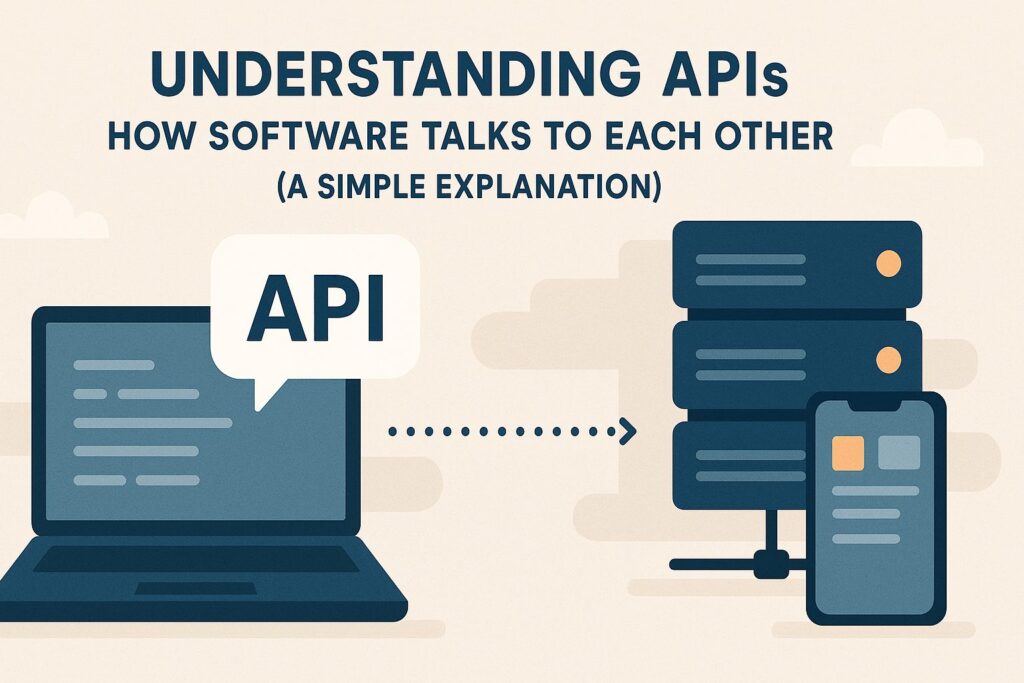Have you ever wondered how your favorite weather app gets the latest forecast? Or how you can log into one website using your Google or Facebook account? The answer, in large part, is APIs.
APIs are everywhere in the digital world, quietly working behind the scenes to make our connected experiences possible. But what exactly is an API? And how do they work?
Let’s break it down in a way that’s easy to understand, no technical jargon required!
What is an API? The Restaurant Analogy
Imagine you’re sitting at a table in a restaurant. You want to order food, but you can’t just walk into the kitchen and tell the chef what you want. There’s a process.
1. You look at the menu (the list of things you can order).
2. You tell the waiter what you want from the menu.
3. The waiter takes your order to the kitchen.
4. The kitchen prepares your food.
5. The waiter brings the food back to your table.
In this analogy:
- You (the customer): The user or the piece of software that wants information or wants to perform an action.
- The Kitchen: The system or database that holds the information or can perform the action (like a weather service database, a social media platform’s user data, etc.).
- The Food: The information or the result you get back.
- The Menu: The documentation or definition of what requests you can make and what responses you’ll get back.
- The Waiter: This is the API (Application Programming Interface)!
The waiter (API) is the intermediary. It takes your request, communicates it to the kitchen (the system), and delivers the response back to you. You don’t need to know how the kitchen prepares the food, just what you can order and trust the waiter to handle the communication.
How Do APIs Work? The Digital Conversation
In the digital world, software applications need to talk to each other constantly. An API is essentially a set of rules and definitions that dictate how one piece of software can request information or functionality from another piece of software.
Think of it as a digital contract. One application says, “Here are the specific ways you can ask me for things,” and the other application agrees to ask only in those specific ways.
Here’s a simplified look at the process:
1. A Request is Made: One application (let’s call it the “client,” like your weather app) sends a request to another application (the “server,” like the weather service). This request is formatted according to the API’s rules.
2. The API Receives and Translates: The API acts as the gateway. It receives the request, understands what the client is asking for, and translates it into a language the server can understand.
3. The Server Processes: The server processes the request (e.g., looks up the weather for a specific city).
4. A Response is Sent Back: The server sends the requested information or the result of the action back to the API.
5. The API Delivers: The API receives the response, formats it in a way the client can understand, and sends it back to the client application.
This data exchange between applications happens incredibly fast, often in milliseconds!
Why Are APIs Important? Connecting the Digital Dots
APIs are fundamental to almost everything we do online today. Here’s why are APIs important:
- Enable Integration: APIs allow different software systems, built by different companies, to connect and work together seamlessly. This is how your project management tool might integrate with your calendar, or how an e-commerce site connects with a payment gateway.
- Power Mobile Apps: Mobile apps on your phone rarely store all the data themselves. They use APIs to fetch data from remote servers (like getting tweets for your Twitter app or product listings for a shopping app).
- Facilitate Innovation: By providing access to their data or functionality through APIs, companies allow other developers to build new and creative applications on top of their platform. Think of all the apps built using the Google Maps API or social media APIs.
- Improve Efficiency: Instead of building everything from scratch, developers can use existing APIs to add complex features (like maps, payments, or login systems) to their own applications quickly.
- Enhance User Experience: APIs allow for dynamic, real-time information and features within applications, making them more powerful and user-friendly.
Real-World API Examples You Use Every Day
You interact with APIs constantly without even realizing it! Here are a few api real world examples:
- Checking the Weather: Your weather app uses an API to get data from a weather service.
- Logging in with Google/Facebook: When you click “Login with Google,” you’re using an API that allows the website you’re visiting to securely verify your identity with Google.
- Online Shopping: When you make a purchase, the e-commerce site uses APIs to process your payment through a payment gateway like Stripe or PayPal. They might also use APIs for shipping calculations or inventory management.
- Travel Booking Sites: Sites like Expedia or Kayak use APIs to pull flight and hotel information from various airlines and hotel chains.
- Embedding Maps: When you see a Google Map embedded on a website, that site is using the Google Maps API.
Types of APIs (Briefly)
While the core concept is the same, APIs come in different styles. One of the most common types you’ll hear about is REST API. REST (Representational State Transfer) is an architectural style for designing networked applications, and it’s widely used for web APIs. Don’t worry too much about the different types for a basic understanding, just know that REST is a popular way to build them.
Conclusion: APIs – The Unsung Heroes of the Digital Age
APIs are the invisible threads that connect the vast tapestry of the internet and software applications. They enable seamless communication, foster innovation, and make our digital lives more integrated and convenient.
Next time you see two different apps working together, or get real-time information on your phone, you’ll know that an API is likely hard at work, acting as the reliable waiter bringing information from the kitchen to your table.
Understanding APIs, even at a basic level, helps demystify how modern software connects and operates. They are truly the unsung heroes of the digital age!



